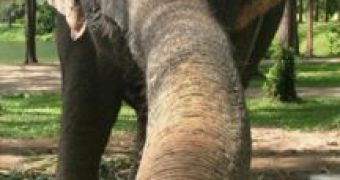So, what are those long noses for?
They want to suggest something in order to ashame human males? No, even if at this chapter, too, the elephants are champions. In fact, a trunk can sniff at a long distance from the owner's face, grab things, or march across a pool underwater, using it as a snorkel. Because the trunk does not have bones, it's extremely mobile. In fact, nose bones are greatly reduced, and not only in elephants, but also in other mammals that developed rudimentary trunks (like tapirs).
A trunk contains more than 40,000 muscles and tendons, and its tip is very sensitive, making it very precise (elephants can pick up from the floor objects by the size of a coin).
In addition, there is one (in African elephant) or two (in Asian elephant) "fingers" on the tip to grasp small objects. This prehensile "hand" can weigh 400 lb. (160 kg) and measure 7 feet (2,1 m) long, being able to lift objects of more than 300 lb. (120 kg).
The elephant can collect gallons of water with the trunk and then give itself a quick shower; or reach the highest, freshest leaves off a tree.
It may be used to chase away flies or to hug affectionately another elephant's trunk. Changes in nostril size shift the sound of the elephant calls. Elephants also wade into pools, submerged, and use the tip of their trunk as a snorkel as it swims to the other side, breathing easily.
Humans can only use a foot long snorkel tubes, because for deeper snorkels the mismatch between air pressure inside lungs and the increasing outside pressure can make blood vessels swell and rupture.
But elephant lungs are different: instead of having a pleural space between lungs and the chest case as humans and most mammals do, elephants have dense sheets of fibery tissue, allowing their lungs to withstand pressures that would cause human lungs to collapse. This is a sign that elephant ancestors were aquatic creatures.
Indeed, their closet living relatives seem to be the sea cows, like manatees and dugongs. Some suspect that the elephant's trunk initially evolved as a snorkel, which also proved useful for gathering food. As animals born with long trunks had an advantage, they thrived. Eventually, modern elephants with long, strong trunks evolved and flourished.
But the aquatic theory is not enough. The long trunks seem to be linked also with the giant size of the elephants. At this size, the heavy head of an elephant could not be mechanically supported by a long neck. Even if elephants have hollow skull bones, the skull is not light enough. To dwarf the skull would have meant to dwarf also the brain. But elephants are among the most intelligent animals, and losing the advantage of a smart brain is not advantageous in evolution.
Moreover, elephants have a special dentition, which largely impedes size fluctuations in their heads. So, being a giraffe was not an option. Not to mention the physiological problems the giraffes face with their long necks, which finally limit their size to that of the current species.
Another issue: there are other huge beasts with huge heads and without a trunk: the rhinoceros (well, in this case, it is not the brain that weights so much, but the horns). But the difference is that, while rhinos are short with their short limbs, elephants are really high and long-limbed. They need them for their long migration walks.
So, even if the trunk initially evolved like a snorkel in ancient elephants, after that, it evolved even more as the solving tool for three evolutionary directions of the elephants: giant size, long limbs, and big brains. Being tall, big and short necked would let elephants hungry without the trunk, as they would be unable to feed. In fact, elephants affected by a viral disease that paralyzes the trunk die quickly of hunger.

 14 DAY TRIAL //
14 DAY TRIAL //